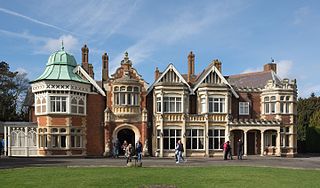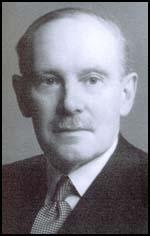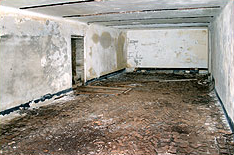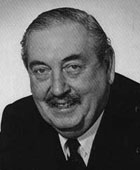
Whaddon Hall is a country house in Whaddon, Buckinghamshire. It is a Grade II listed building. [1]

Whaddon Hall is a country house in Whaddon, Buckinghamshire. It is a Grade II listed building. [1]

The first manor house was built on the site in the 11th century. The present house was built in 1820, replacing a house which was demolished in the late 18th century. [2] [3] It was once home to the Selby family (also known as Selby-Lowndes), whose ancestor William Lowndes built the larger and grander Winslow Hall. [4]
During the Second World War Whaddon Hall served as headquarters of Section VIII (Communications) of the Secret Intelligence Service (SIS, or MI6), under the command of Brigadier Richard Gambier-Parry. The "Station X" wireless interception function was transferred here from Bletchley Park in February 1940. [5] That facility, known as Main Line, served in a number of capacities, the most critical the sending of Ultra intelligence from Bletchley Park to officers in the field. [6] The term Ultra was used to convey the status of the intelligence which was considered to be above Top Secret. It consisted of information that was gathered by breaking encrypted radio communications. [7]
At the time that France fell to the Axis Powers in June 1940, only a small number of SIS agents were in communication with Whaddon Hall. Early in the war, until about 1941, inexperienced SIS agents on the European continent spent too much time on the air, and jeopardised their security. However, by 1943, Gambier-Parry and his staff had engineered a substantial improvement in clandestine wireless communication. [8] The covert wireless network that Gambier-Parry established allowed him to stay in communication with SIS agents in many countries. [9]
The hall was converted for industrial use in the early 1960s and into a country club in the 1970s. [10] Following a serious fire in 1976, [1] it was refurbished and in the 1980s converted into flats; [10] as of 2017 [update] it is divided into four units. [3]

Bletchley Park is an English country house and estate in Bletchley, Milton Keynes (Buckinghamshire) that became the principal centre of Allied code-breaking during the Second World War. The mansion was constructed during the years following 1883 for the financier and politician Sir Herbert Leon in the Victorian Gothic, Tudor, and Dutch Baroque styles, on the site of older buildings of the same name.

Ultra was the designation adopted by British military intelligence in June 1941 for wartime signals intelligence obtained by breaking high-level encrypted enemy radio and teleprinter communications at the Government Code and Cypher School (GC&CS) at Bletchley Park. Ultra eventually became the standard designation among the western Allies for all such intelligence. The name arose because the intelligence obtained was considered more important than that designated by the highest British security classification then used and so was regarded as being Ultra Secret. Several other cryptonyms had been used for such intelligence.

The Security Service, also known as MI5, is the United Kingdom's domestic counter-intelligence and security agency and is part of its intelligence machinery alongside the Secret Intelligence Service (MI6), Government Communications Headquarters (GCHQ), and Defence Intelligence (DI). MI5 is directed by the Joint Intelligence Committee (JIC), and the service is bound by the Security Service Act 1989. The service is directed to protect British parliamentary democracy and economic interests and to counter terrorism and espionage within the United Kingdom (UK).
MI8, or Military Intelligence, Section 8 was a British Military Intelligence group responsible for signals intelligence and was created in 1914. It originally consisted of four sections: MI8(a), which dealt with wireless policy; MI8(b), based at the General Post Office, dealt with commercial and trade cables; MI8(c) dealt with the distribution of intelligence derived from censorship; and MI8(d), which liaised with the cable companies. During World War I MI8 officers were posted to the cable terminals at Poldhu Point and Mullion in Cornwall and Clifden in County Galway, continued until 1917 when the work was taken over by the Admiralty. In WW2, MI8 was responsible for the extensive War Office Y Group and briefly, for the Radio Security Service.

Major General Sir Stewart Graham Menzies, was Chief of MI6, the British Secret Intelligence Service (SIS), from 1939 to 1952, during and after the Second World War.

Winslow is a market town and civil parish designated as a town council in north Buckinghamshire, England, within the Buckinghamshire Council unitary authority area. It has a population of just over 4,400. It is located approximately 6 miles (9.7 km) south-east of Buckingham, and 7 miles (11 km) south-west of Bletchley.

Bletchley is a constituent town of Milton Keynes, Buckinghamshire, England. It is situated in the south-west of Milton Keynes, and is split between the civil parishes of Bletchley and Fenny Stratford and West Bletchley.

Whaddon is a village and also a civil parish in Buckinghamshire, England, within the Buckinghamshire Council unitary authority area. It is situated just outside of Bletchley, a constituent town of Milton Keynes.
Cryptography was used extensively during World War II because of the importance of radio communication and the ease of radio interception. The nations involved fielded a plethora of code and cipher systems, many of the latter using rotor machines. As a result, the theoretical and practical aspects of cryptanalysis, or codebreaking, were much advanced.

Rockex, or Telekrypton, was an offline one-time tape Vernam cipher machine known to have been used by Britain and Canada from 1943. It was developed by Canadian electrical engineer Benjamin deForest Bayly, working during the war for British Security Coordination.

His Majesty's Government Communications Centre (HMGCC) is an organisation which provides electronics and software to support the communication needs of the British Government. Based at Hanslope Park, near Milton Keynes in Buckinghamshire, it is closely linked with the Foreign, Commonwealth and Development Office and the British intelligence community.

Winslow Hall is a country house, now in the centre of the small town of Winslow, Buckinghamshire, England. Built in 1700, it was sited in the centre of the town, with a public front facing the highway and a garden front that still commanded 22 acres (89,000 m2) in 2007, due to William Lowndes' gradual purchase of a block of adjacent houses and gardens from 1693 onwards. The architect of the mansion has been a matter of prolonged architectural debate; the present candidates are Sir Christopher Wren or a draughtsman, whether in the Board of Works, which Wren oversaw, or a talented provincial architect.
The "Y" service was a network of British signals intelligence collection sites, the Y-stations. The service was established during the First World War and used again during the Second World War. The sites were operated by a range of agencies including the Army, Navy and RAF plus the Foreign Office, General Post Office and Marconi Company receiving stations ashore and afloat. There were more than 600 receiving sets in use at Y-stations during the Second World War.
Before the development of radar and other electronics techniques, signals intelligence (SIGINT) and communications intelligence (COMINT) were essentially synonymous. Sir Francis Walsingham ran a postal interception bureau with some cryptanalytic capability during the reign of Elizabeth I, but the technology was only slightly less advanced than men with shotguns, during World War I, who jammed pigeon post communications and intercepted the messages carried.
The Diplomatic Wireless Service (DWS) was the name of the communications system set up for the British Foreign Office by Brigadier Richard Gambier-Parry, the first Foreign Office Director of Communications, in the latter part of 1945. It grew out of the Special Communication Units (SCU) which were responsible for communications for MI6 during the war. Its original base was at Whaddon Hall in Buckinghamshire, but it moved to Hanslope Park in the winter of 1946/47. The primary role of the DWS was communications between British embassies and the UK, this part of its operations being based at Hanslope Park, which is still the HQ of its successor, Her Majesty's Government Communications Centre (HMGCC).

Operation Tracer was a secret Second World War military operation in Gibraltar, a British Overseas Territory and military base. The impetus for the plan was the 1940 scheme by Germany to capture Gibraltar, code-named Operation Felix. Operation Tracer was the brainchild of Rear Admiral John Henry Godfrey, the Director of the Naval Intelligence Division of the Admiralty.

Brigadier Sir Richard Gambier-Parry, was a British military officer who served in both the army and the air force during World War I. He remained in military service post-war, but then entered into civilian life for more than a decade. In 1938, he was recruited by the head of the Secret Intelligence Service. Gambier-Parry led the Communications Section of the SIS during World War II, and assembled a clandestine wireless network that connected the United Kingdom with SIS agents in many countries, as well as helping to create the SIS resistance network in Britain. During the war, he was also recruited by the Director of British Naval Intelligence to serve as the radio consultant for Operation Tracer in Gibraltar. Post-war, he ran a network of secret listening stations.

The Secret Intelligence Service (SIS), commonly known as MI6, is the foreign intelligence service of the United Kingdom, tasked mainly with the covert overseas collection and analysis of human intelligence on foreign nationals in support of its Five Eyes partners. SIS is one of the British intelligence agencies and the Chief of the Secret Intelligence Service ("C") is directly accountable to the Foreign Secretary.
The Government of the United Kingdom maintains several intelligence agencies that deal with secret intelligence. These agencies are responsible for collecting, analysing and exploiting foreign and domestic intelligence, providing military intelligence, and performing espionage and counter-espionage. Their intelligence assessments contribute to the conduct of the foreign relations of the United Kingdom, maintaining the national security of the United Kingdom, military planning, public safety, and law enforcement in the United Kingdom. The four main agencies are the Secret Intelligence Service, the Security Service (MI5), the Government Communications Headquarters (GCHQ) and Defence Intelligence (DI). The agencies are organised under three government departments, the Foreign Office, the Home Office and the Ministry of Defence.